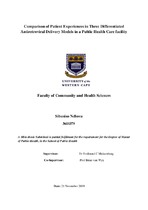Comparison of patient experiences in three differentiated antiretroviral delivery models in a public health care facility
Abstract
Background: HIV remains a global concern. Consequently, global institutions such as the World Health Organisation (WHO) and United Nations Programme on HIV and AIDS (UNAIDS) continue to work towards ending HIV/AIDS by facilitating innovative strategies to improve service delivery of antiretroviral therapy (ART). In 2016 WHO issued the ‘test and treat’ policy recommendation in line with the UNAIDS 2020, 90-90-90 target of reaching 90% people to know their HIV status, get 90% of these on ART treatment and to have 90% of those on treatment virally suppressed. Differentiated Care Models (DCMs) has been put in place for all stakeholders, from global, institutes, government departments and civil society to improve patient access to treatment and retention in care. While various evaluation studies have shown that DCMs improve the retention in care and adherence to medication behaviours of patients on ART, little is known about the patients’ experiences and preferences.
The aim of the current study was to explore and compare the experiences of patients in three DCMs (Facility Adherence Clubs [FAC], Community Adherence Club [CAC] and Quick Pharmacy Pick-up [QPUP]) in a community health care facility in a township in Cape Town, South Africa.
Methods: An exploratory qualitative study design was used. Data were collected through semi-structured interviews (12) and focus group discussions (6) with purposively selected participants from six DCMs. Thematic analysis was done using Atlas.ti version 8.0.
Results: Patients found DCMs easily accessible and convenient and presented positive experiences in relation to the National Health Services (NHS) patients experience principles. FACs and CAC presented attributes of patient-centeredness as prescribed by the NHI. We found that the QPUP model fell short on attributes of patient-centeredness such as coordination and integration of care, information sharing, communication and education, and emotional/psychological support.
Conclusions: The principles of DCMs acknowledge the diversity and preference of PLHIV in addressing the barriers they face in accessing ART while empowering these patients to self-manage their disease. Understanding the experiences of patients using DCMs could improve our understanding of how DCMs promote self-management among PLHIV (or not) and some of the challenges faced by the patients using these care models. This understanding could inform strategies to tailor ART delivery services that suit the patients’ needs and enhance their abilities to achieve optimal retention in care and viral suppression.

